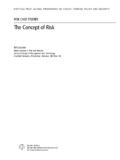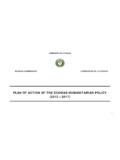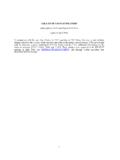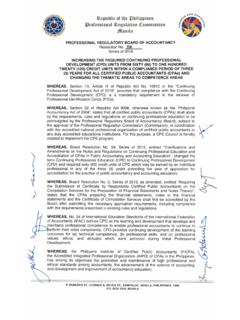Transcription of Financial Action Task Force Groupe d'action …
1 Financial Action Task Force Groupe d' Action financi re RBA GUIDANCE FOR DEALERS IN PRECIOUS METAL AND STONES 17 June 2008 FATF/OECD 2008 All rights reserved. No reproduction, copy, transmission or translation of this publication may be made without written permission. Applications for permission to reproduce all or part of this publication should be made to: FATF Secretariat, OECD, 2 rue Andr Pascal 75775 Paris Cedex 16, France TABLE OF CONTENTS SECTION ONE: USING THE GUIDANCE - PURPOSE OF THE RISK-BASED APPROACH .. 1 Chapter One: Background and Context .. 1 Chapter Two: The Risk-Based Approach Purpose, Benefits and Challenges .. 3 Chapter Three: FATF and the Risk-Based Approach .. 6 SECTION TWO: GUIDANCE FOR PUBLIC AUTHORITIES.
2 11 Chapter One: High-Level Principles for Creating a Risk-Based Approach .. 11 Chapter Two: Implementation of the Risk-Based Approach .. 14 SECTION THREE: GUIDANCE FOR DEALERS ON IMPLEMENTING A RISK-BASED APPROACH .. 20 Chapter One: Risk Categories .. 20 Chapter Two: Application of a risk based approach .. 27 Chapter Three: Internal Controls .. 29 ANNEXES .. 32 ANNEX 1 SOURCES OF FURTHER INFORMATION .. 32 ANNEX 2 GLOSSARY OF TERMINOLOGY .. 34 ANNEX 3 MEMBERS OF THE ELECTRONIC ADVISORY GROUP .. 36 GUIDANCE ON THE RISK-BASED APPROACH TO COMBATING MONEY LAUNDERING AND TERRORIST FINANCING HIGH LEVEL PRINCIPLES AND PROCEDURES FOR DEALERS IN PRECIOUS METALS AND DEALERS IN PRECIOUS STONES SECTION ONE: USING THE GUIDANCE PURPOSE OF THE RISK-BASED APPROACH Chapter One: Background and Context 1. In June 2007 the FATF adopted Guidance on the Risk-Based Approach to Combating Money Laundering and Terrorist Financing: High Level Principles and Procedures, which includes guidance for public authorities and guidance for Financial institutions.
3 This was the culmination of extensive consultation between private and public sector members of an Electronic Advisory Group (EAG) established by the FATF. 2. In addition to Financial institutions, the FATF Recommendations also cover a number of designated non- Financial businesses and professions (DNFBPs). At its June 2007 meeting, the FATF's Working Group on Evaluations and Implementation (WGEI) endorsed a proposal to convene a meeting of the representatives from the DNFBPs to assess the possibility of developing guidance on the risk-based approach for their sectors, using the same structure and style as the completed guidance for Financial institutions. 3. This meeting was held in September 2007 and was attended by organisations which represent lawyers, notaries, accountants, trust and company service providers, casinos, real estate agents, and dealers in precious metals and dealers in precious stones.
4 This private sector group expressed an interest in contributing to FATF guidance on implementing a risk-based approach for their sectors. The guidance for the DNFBPs would follow the principles of the risk-based approach already established by FATF, and would highlight risk factors specific to the DNFBPs, as well as suggest mitigation strategies that fit with the particular activities and businesses of the DNFBPs. The FATF established another EAG to facilitate the work. 4. The private sector group met again in December 2007 and was joined by a number of specialist public sector members. Separate working groups comprising public and private sectors members were established, and private sector chairs were appointed. 5. The EAG continued work until this guidance for dealers in precious metals and dealers in precious stones was presented to the WGEI.
5 After further international consultation with both public and private sectors, the FATF adopted this guidance at its June 2008 Plenary. Guidance for each of the other DNFBP sectors is being published separately. Purpose of the guidance 6. The purpose of this Guidance is to: Support the development of a common understanding of what the risk-based approach involves. Outline the high-level principles involved in applying the risk-based approach. Indicate good practice in the design and implementation of an effective risk-based approach. 7. However, it should be noted that applying a risk-based approach is not mandatory. A properly applied risk-based approach does not necessarily mean a reduced burden, although it should result in a more cost effective use of resources.
6 For some countries, applying a rules-based system might be more appropriate. Countries will need to make their own determinations on whether to apply a risk-based approach, based on their specific ML/FT risks, size and nature of the DNFBP activities, and other relevant information. The issue of timing is also relevant for countries that may have applied anti-money laundering/counter-terrorist financing (AML/CFT) measures to DNFBPs, but where it is uncertain whether the DNFBPs have sufficient experience to implement and apply an effective risk-based approach. Target audience, status and content of the guidance 8. This Guidance is written at a high level to recognize the differing practices of dealers in precious metals and dealers in precious stones (hereinafter referred to as dealers ) in different countries, and the different levels and forms of monitoring that may apply.
7 Each country and its national authorities should aim to establish a partnership with its dealers that will be mutually beneficial to combating money laundering and terrorist financing. 9. The primary target audience of this guidance is dealers in precious metals and dealers in precious stones themselves, when they conduct activities which fall within the ambit of the FATF Recommendations, as described below. For purposes of this guidance, the term "dealer" encompasses a wide range of persons engaged in these businesses, from those who produce precious metals or precious stones at mining operations, to intermediate buyers and brokers, to precious stone cutters and polishers and precious metal refiners, to jewellery manufacturers who use precious metals and precious stones, to retail sellers to the public, to buyers and sellers in the secondary and scrap markets.
8 10. Recommendation 12 mandates that the requirements for customer due diligence, record-keeping, and paying attention to all complex, unusual large transactions set out in Recommendation 5, 6, and 8 to 11 apply to dealers in precious metals and dealers in precious stones when they engage in any cash transaction with a customer equal to or above USD/EUR 15 000. 11. Recommendation 16 requires that FATF Recommendations 13 to 15 regarding reporting of suspicious transactions (see paragraph 132) and internal AML/CFT controls, and Recommendation 21 regarding measures to be taken with respect to countries that do not or insufficiently comply with the FATF Recommendations, apply to dealers in precious metals and dealers in precious stones when they engage in any cash transaction with a customer equal to or above the applicable designated threshold (USD/EUR 15 000).
9 12. The wider audience for this guidance includes countries, designated competent authorities and self regulatory organisations (SROs), which are considering how to apply AML/CFT measures to dealers. Countries need to identify the most appropriate regime, tailored to address individual country risks, which takes into consideration the idiosyncrasies and activities of dealers domestically. This regime should recognise the differences between the DNFBP sectors, as well as the differences between the DNFBPs and Financial institutions. However, this guidance does not override the purview of national authorities. 2 Observation on the particular activities carried out by dealers 13. The following general observation about the different businesses carried out by dealers should help inform the approach.
10 Consideration should also be given to the particular activities performed by dealers on a national basis. 14. Diamonds, jewels and precious metals have unique physical and commercial properties which carry value in small, easily transportable quantities. The worldwide trade varies from modern international transactions conducted through the Financial system, to localized informal markets. Dealers range from very poor individuals in some of the most remote and troubled places on the planet, to the wealthiest individuals, to large multinational companies working in major Financial centres. Transaction methods also range from anonymous exchanges of handfuls of stones or nuggets for cash, to exchange-based government-regulated deals. 15.
















